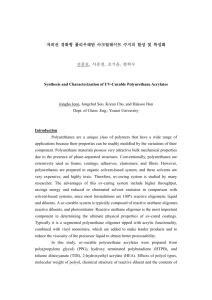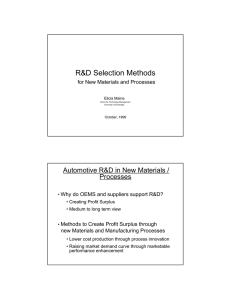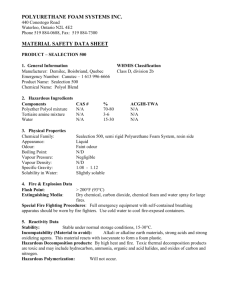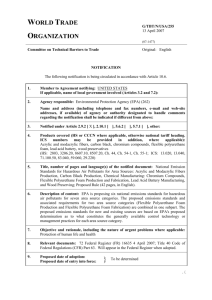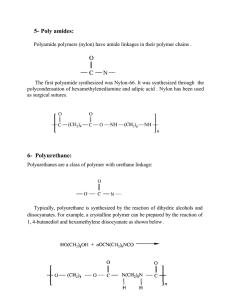Document 14212243
advertisement
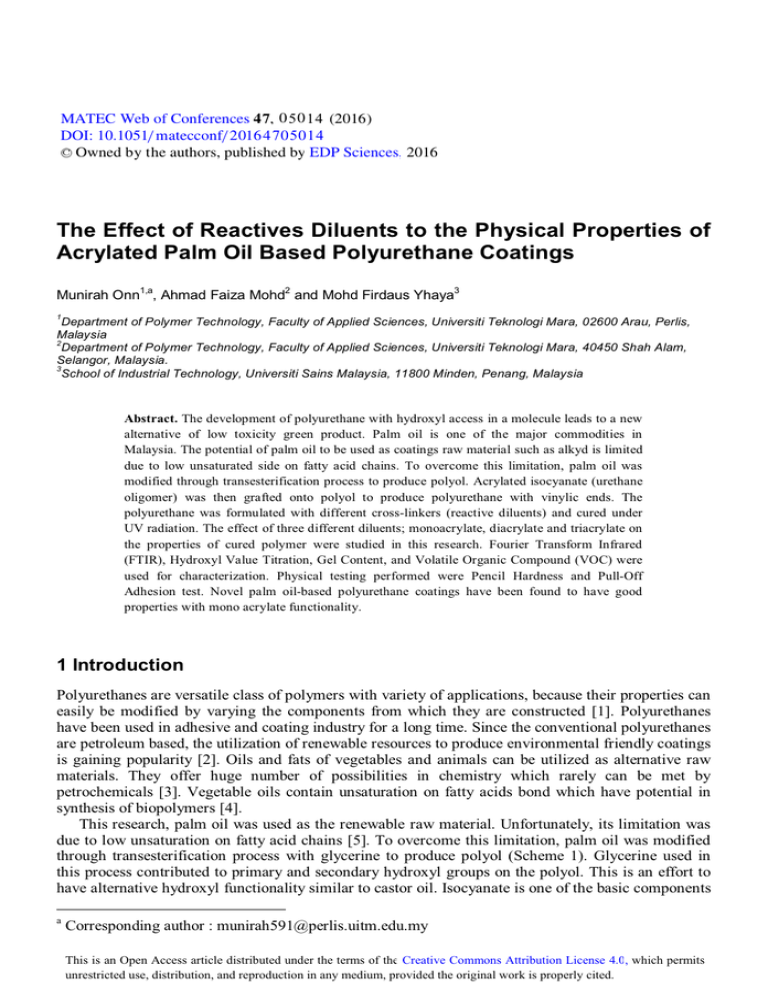
MATEC Web of Conferences 4 7, 0 5 0 14 (2016 ) DOI: 10.1051/ m atecconf/ 2016 47 0 5 0 14 C Owned by the authors, published by EDP Sciences, 2016 The Effect of Reactives Diluents to the Physical Properties of Acrylated Palm Oil Based Polyurethane Coatings Munirah Onn1,a, Ahmad Faiza Mohd2 and Mohd Firdaus Yhaya3 1 Department of Polymer Technology, Faculty of Applied Sciences, Universiti Teknologi Mara, 02600 Arau, Perlis, Malaysia Department of Polymer Technology, Faculty of Applied Sciences, Universiti Teknologi Mara, 40450 Shah Alam, Selangor, Malaysia. 3 School of Industrial Technology, Universiti Sains Malaysia, 11800 Minden, Penang, Malaysia 2 Abstract. The development of polyurethane with hydroxyl access in a molecule leads to a new alternative of low toxicity green product. Palm oil is one of the major commodities in Malaysia. The potential of palm oil to be used as coatings raw material such as alkyd is limited due to low unsaturated side on fatty acid chains. To overcome this limitation, palm oil was modified through transesterification process to produce polyol. Acrylated isocyanate (urethane oligomer) was then grafted onto polyol to produce polyurethane with vinylic ends. The polyurethane was formulated with different cross-linkers (reactive diluents) and cured under UV radiation. The effect of three different diluents; monoacrylate, diacrylate and triacrylate on the properties of cured polymer were studied in this research. Fourier Transform Infrared (FTIR), Hydroxyl Value Titration, Gel Content, and Volatile Organic Compound (VOC) were used for characterization. Physical testing performed were Pencil Hardness and Pull-Off Adhesion test. Novel palm oil-based polyurethane coatings have been found to have good properties with mono acrylate functionality. 1 Introduction Polyurethanes are versatile class of polymers with variety of applications, because their properties can easily be modified by varying the components from which they are constructed [1]. Polyurethanes have been used in adhesive and coating industry for a long time. Since the conventional polyurethanes are petroleum based, the utilization of renewable resources to produce environmental friendly coatings is gaining popularity [2]. Oils and fats of vegetables and animals can be utilized as alternative raw materials. They offer huge number of possibilities in chemistry which rarely can be met by petrochemicals [3]. Vegetable oils contain unsaturation on fatty acids bond which have potential in synthesis of biopolymers [4]. This research, palm oil was used as the renewable raw material. Unfortunately, its limitation was due to low unsaturation on fatty acid chains [5]. To overcome this limitation, palm oil was modified through transesterification process with glycerine to produce polyol (Scheme 1). Glycerine used in this process contributed to primary and secondary hydroxyl groups on the polyol. This is an effort to have alternative hydroxyl functionality similar to castor oil. Isocyanate is one of the basic components a Corresponding author : munirah591@perlis.uitm.edu.my 4 MATEC Web of Conferences in producing polyurethane. Isophorone diisocyanate (IPDI) was monoacrylated with 2-hydroxylethyl acrylate (HEA) to form urethane oligomer, which was later grafted onto polyol to produce polyurethane with vinylic ends. Different types of reactive diluents; monoacrylate, diacrylate and triacrylate were used as cross-linkers. O H 2C O C O HC O C O H2C O C palm oil triglyceride OH HO transesterification OH glycerine OH OH O H2C OH O OH O HC + O=C=N HN O C OH O O OH H2C O polyol O urethane oligomer OR OR H2 C O OR O OR HC O with R = C OR N NH H OR H2 C O O O O O=C O acrylated polyurethane Scheme 1. Synthesis of polyurethane. 2 Experimental 2.1 Materials Triglyceride palm oil (824 g/mol) from Sri Murni brand was used. Fatty acid ester was found to be around 2.0. Glycerol (92.09 g/mol) was supplied by May & Baker Ltd. Dagenham, England were used. Isopohorone diisocyanate (IPDI) and 2-hydroxylethyl acrylate (HEA) were supplied by SigmaAldrich. p-toluenesulfonic acid (PTSA), dibutyltin dilaurate (DBTL) and hydroquinone (as catalysts) were used as received. Acetone as solvent in polymerization process was supplied by Sigma-Aldrich. Three (3) types of reactive diluents were used; butyl-methacrylate, tripropyleneglycol diacrylate (TPGDA), Trimethylolpropane triacrylate (TMPTA). Irgacure 500 supplied by CIBA was used as photoinitiator and N-methylpyrrolidone (NMP) from Sigma-Aldrich was used as received. 05014-p.2 IConCEES 2015 2.2 Instrumentation FTIR spectroscopic measurements using KBr pellets were carried out using Perkin-Elmer IR spectrometer and the samples were cured under Fusion UV radiation curing machine (80 kW) lamp. 2.3 Synthesis The process began with transesterification reaction of palm oil to produce polyols. The transesterification process was done with the access of one mole triglyceride, 4 mole of glycerine and 6 mole of methanol. 5% PTSA was used as catalyst. Palm oil, glycerin and methanol were charged into 500 mL multi-neck reaction flask equipped with a stirrer, thermometer, water cooled condenser, and nitrogen inlet. Catalyst was added after the reaction temperature reached 50°C and stir rate was set to 550 – 650 rpm. Hydroxyl value test was done during the reaction to obtain the optimum hydroxyl value of polyol from palm oil. The formation of urethane oligomer was done by charging one mole IPDI and one mole HEA into multi-neck reaction flask. 1% DBTL was used as catalyst and 0.5% hydroquinone was added to inhibit further reaction. FTIR was used to monitor the progress of urethane oligomer formation.Polyol from palm oil was then physically blended with urethane oligomer to form polyurethane resin. The reactions occur at room temperature and the resin was characterized by FTIR. 3 types of reactive diluents were used as cross-linkers; monoacrylate, diacrylate and triacrylate. Polyurethane was mixed well with reactive diluents, 3% of photoinitiator (Irgacure 500) and 1% of film formation agents (NMP). The ratio between polyurethane resin and reactive diluents were varied from 50% to 100%. The coatings were applied on the glass substrates as thin films (40μm) by using hand coater and cured under Fusion UV radiation light conveyer at constant speed 3.2 m/min, 80 kW bulb with 15 cm light intensity with one pass. 2.4 Physical testing Gel content test was done on the cured samples. The cured films were carefully peeled off from the glass substrates and then weighed. A known weight of the cured films was extracted in acetone at 32°C for 24 hours. The residues were dried at 50°C to a constant weight. The gel content of the cured film was then determined by the following equation. Gel Content (%) = Wt / Wo X 100 (1) where Wt is the weight after extraction and Wo is the weight before extraction. Volatile organic compound test was conducted to determine the amount of volatile compounds in cured samples. These compounds have low boiling point and high vapor pressure. The cured samples were weighed and put under 120°C for 2 hours. After 2 hours samples were taken out and weighed. The percent of volatile organic compounds was calculated by following equation : %VOC = (Wf-Wi) / Wi X 100) (2) where Wi is initial weight and Wf is final weight. The hardness test was done by pencil hardness and referring to ASTM D3363 as standard method. This test uses special pencils with different degrees of hardness to scratch the coating as indication of hardness. The amount of pressure and the angle of the pencil to the substrate affect the results. By referring to ASTM D3363 standard method, pull-off adhesion test was done using a portable Defelsco posi test MP 2571 adhesion tester. A load was increasingly applied to the surface until the dolly was pulled off. The force required to pull the dolly off yielded the tensile strength in MegaPascals (MPa). 05014-p.3 MATEC Web of Conferences 3 Experimental 3.1 Synthesis and characterization test Three different types of acrylates (reactive diluents/cross-linkers) were used in this research: butyl acrylate, tripropyleneglycol diacrylate (TPGDA), and trimethylolpropane triacrylate (TMPTA) with acrylate functionality of one, two, and three, respectively. In theory, more acrylates should translate to better physical properties due to the higher cross-linking density. Hydroxyl value of polyol obtained from palm oil was calculated to be 1331.12 mg NaOH/g using hydroxyl value titration method. Higher hydroxyl values indicate better properties by the polyurethane resin, because more urethane linkages can be formed. FTIR spectra showed the formation of polyol from palm oil. The formation of hydroxyl in polyol was detected at 3307 cm-1 (Figure 1). Figure 1. FTIR spectra of polyol. Figure 2. FTIR-spectra of urethane oligomer. The formation of urethane oligomer was determined by FTIR spectroscopy. The presence of isocyanate and hydroxyl was detected at 2260 cm-1 and a broad peak at 3200 cm-1, respectively. The spectrum shows the peak at three time interval (1st, 2nd and 3rd). By measuring the peak area of NCO peak, it was possible to give an estimate of the degree of urethane formation. Intensity of absorption bands at 1709 cm-1 (C=O) and 1120 (C-O) shows the present of urethane linkage. The hydrogenbonded NH peaks can also be observed at 3200 cm-1. However this peak overlapped with hydroxyl broad peak as shown in Figure 2. The process was stopped when half of the initial NCO contents were eliminated. The remaining NCO groups were used in the formation process of acrylated polyurethane. Acrylated polyurethane was synthesized by mixing the polyol from palm oil with the urethane oligomer. The full formation of acrylated polyurethane took about 9 hours as indicated by the NCO peak at 2260 cm-1 (Figure 3). The peak intensity for isocyanate decreased during the reaction and totally depleted at the end of the reaction as shown in Figure 4. The formation of acrylated polyurethane was further judged through the reduction of peak intensity of OH at 3300-3400 cm-1. 3.2 Gel content test Gel content values obtained from the test can be used to predict the degree of cross-linking after UV curing process because the gel content is proportional to degree of cross-linking. The measurements indicate the amount of insoluble material in a cross-linked sample. The higher the percentage of gel content, the higher the degree of cross-linking. Gel content of control sample was found to be 83%. Degree of cross-linking in cured coatings can be varied by adding the different types of reactive diluents; acrylates and varying the ratio between resin and acrylates. The percentages obtained were 05014-p.4 IConCEES 2015 relatively high, indicating that the coatings were highly cross-linked material. When acrylates were added into the formulation, the acrylates cross-linked the long polyurethane chains together which altered the chemical and physical characteristics. 9 HOURS 2249.24 2138.31 3880.27 3736.01 773.61 809.55 720.26 3367.05 3005.28 985.27 1573.71 1296.85 2851.08 2917.35 7 HOURS1736.95 3982.61 1728.94 3816.25 3750.91 1047.79 1464.82 1538.551409.55 1365.501231.68 1217.77 1204.55 869.07 2264.04 933.08 3001.89 %T 3354.85 809.41 720.17 1385.02 2851.38 2922.52 4000.0 3600 3200 2851.17 2918.21 2800 1365.51 984.73 1574.23 1409.34 1047.93 1464.371338.87 1724.24 1537.71 1296.85 1242.92 1191.51 856.21 675.05 929.82 663.99 910.82 776.22 1299.03 1538.781409.54 1051.37 809.73 1637.61 1464.76 1237.85 720.26 1385.96 1185.13 985.66 1575.77 1363.50 5 HOURS 3930.82 3824.72 3808.22 3787.81 3376.10 678.28 665.81 773.62 2266.12 2400 2000 1800 cm-1 1600 1400 1200 1000 800 650.0 Figure 3. FTIR spectra of acrylated polyurethane. TMPTA TPGDA MONO Table 1. Effect of types of acrylates on coating properties. CONTROL SAMPLE 1 SAMPLE 2 SAMPLE 3 SAMPLE 4 SAMPLE 5 SAMPLE 1 SAMPLE 2 SAMPLE 3 SAMPLE 4 SAMPLE 5 SAMPLE 1 SAMPLE 2 SAMPLE 3 SAMPLE 4 SAMPLE 5 Gel Content (%) 83 72 76 80 82 84 87 90 82 81 86 90 85 85 86 87 VO C (%) 10 11 7 6 7 9 14 12 13 11 7 5 4 7 9 15 05014-p.5 Pencil Hardness 2B 2B 2B 2B 2B 2B 2B 2B 2B B 2B 2B 2B 2B B B Pull-Off Adhesion (MPa) 0.797 1.457 1.247 1.263 1.290 1.257 1.000 0.853 0.673 0.617 1.093 0.573 0.593 0.653 0.550 0.947 MATEC Web of Conferences 3.3 Volatile organic compound (VOC) test Volatile organic compound usually refers to solvent content in the system. The lower the amount of VOC in the coating, the safer it is to be used. The present of VOC will increase the degree of flammability of the coating and also increase the health risk associated with application of the coating. Therefore, there is a maximum level of VOC emission fixed for certain applications. According to the result of VOC test, usage of TPGDA gives relatively high percentage of VOC as compared to another two acrylates; butyl acrylate and TMPTA. When it has less functionality, the acrylate was diluted with more solvent to achieve the volume needed. These lead to faster curing due to solvent evaporation and lead to lower solid content. 3.4 Pencil hardness Hardness is the resistance of a coating to indentation or scratching. ‘H’ stands for hardness and ‘B’ stands for blackness. The hardness of these coatings was found to be between B and 2B. It shows that the coating has a soft feeling surface compared to conventional polyurethane which range from H to 2H. It also been influence by fewer airborne impurities which have time to contact the wet film and lead to softness. 3.5 Pull-off adhesion test Pull-off adhesion test indicates the coating resistance towards the applied perpendicular tensile force when the coatings are forced to be separated from the substrate. According to Figure 6, it shows butyl acrylate gave relatively high coating resistance towards applied force as compared to TPGDA and TMPTA. TPGDA and TMPTA caused higher cross-linking density, which in turn contributed to more rigid coatings. Rigid coatings have higher cohesion between themselves rather than adhesion to the substrates. Figure 4. Gel content of cured film with different types of acrylate loading. Figure 5. VOC of cured films with different types of acrylate loading. 05014-p.6 IConCEES 2015 Graph 6. Pull-off adhesion of cured film with different types of acrylate loading. 4 Conclusions Synthesis of renewable, environmental friendly polyurethane coatings were successfully done through transesterification of palm oil and subsequent modification with acrylated urethane oligomer. Among the reactive diluents, Butyl acrylate is the best reactive diluents to be crosslink with the acrylated palm oil oligomer. References [1] Y.C. Lai, E.T. Quinn, and L.Valint. Control of hard segment size in polyurethane formation. Journal of Polymer Science. 33, 1767–1772, (1995). [2] R.I. Muhammad, D.H. Beg Mohammad and S.J. Saidatul. The effects of increasing unsaturation in palm oil properties. World Academy of Science, Engineering and Technology. International Journal of Chemical, Nuclear, Materials and Metallurgical Engineering, 9, 3-9, (2015). [3] G. Lligadas, I.C. Ronda, M. Galia, V. Cadiz, Novel silicon-containing polyurethanes from vegetable oils as renewable resources. Synthesis and properties, Biomacromolecules 7, 24202426 ,(2006). [4] C.T. Yuan,K. Pimphan, S. Galen and H.H. Fu, Physical properties of water-blown rigid polyurethane foams from vegetable oil-based polyols, Journal of Applied Polymer Science, 105, 453-459, (2007). [5] G. Yanchang and J. Xuesong, Photo-cured materials from vegetable oils, The Royal Society of Chemistry, 1, 1-27, (2015). 05014-p.7
